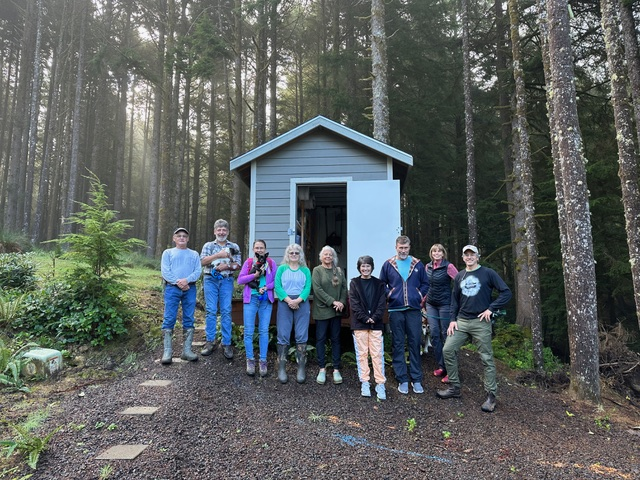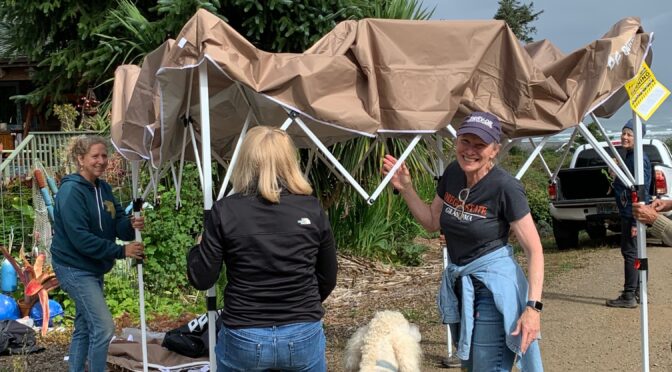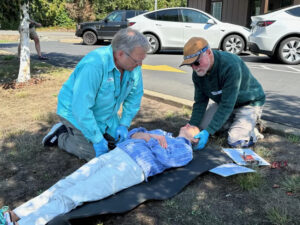CMCA received a second grant from the Tillamook PUD for $4,540.21. The grant will pay for two medical shelters, 20 body bags for deceased survivors, 12 Duckbill tent anchors, 45 sleeping bags, and two radios (one GMRS, one ham). We will store the tents in our Third and Ninth Street emergency storage sheds. Thanks to Miriam Fultz and her team.
Category Archives: Emergency Preparedness Updates
Wilderness First Aid Training Nov 5 & 6
Wilderness First Aid classes are funded locally by Tillamook Coast Visitors Association and taught by instructors from NOLS (National Outdoor Leadership School). The two-day class teaches the Patient Assessment System, how to provide effective first
Great Oregon Shake OutCape Meares 2025

Cape Meares will participate in the Great Oregon Shake Out again this year. Get ready to practice your emergency skills with your family and neighbors. First, at 10:16 am on October 16th, you will practice the mantra of “drop, cover, and hold”. Then, grab your go bag and walk to your assembly site. The sites are located on 9th, 3rd, and 5th streets and at the water tower. There will be someone there to collect participation data and communicate site participation using GMRS radios.
It is important to practice community emergency plans so that all participants can direct their energy toward survival rather than panic.
Don’t be scared. Be prepared.
Tillamook County Emergency Preparedness Summit
Held September 13, 2024
On September 13, 2024 Miriam Fultz and Charles Ansorge attended the Tillamook County Emergency Preparedness Summit held at Tillamook Bay Community College at which time the new name and logo for our group that focuses on emergency preparedness was unveiled. Our group of “preppers” is now known as Cape Meares Emergency Volunteer Corps (CMEVC). Miriam shared information regarding a history of the work that our group has completed since 2010.

Mass Casualty Shelter Drill
On August 12 the Cape Meares Emergency Prep group hosted a Mass Casualty Shelter Drill for the community. Residents were asked to actively engage in the drill in order to gain experience on what might be expected following an earthquake and tsunami that forced them to flee to a safe assembly area above the inundation zone. More than 30 residents participated and self-selected to be a member of a task group that then tested a series of instructions created by the Emergency Prep group.
Following a significant earthquake and tsunami it is unlikely that those who are able to reach safety will be clear-minded regarding what they should do next. We do the planning now for various scenarios without having to deal with the serious stress associated with being a survivor. A major earthquake will not be just one event. During the first 24-48-72 hours post event there might be hundreds of aftershocks with some of them approaching or even exceeding the initial quake. There won’t be just one tsunami. Instead there will be multiple waves that come ashore and continue to inflict serious damage to property in the inundation zone area.
The severity of any event will determine how quickly it might be possible for the ground to stop shaking and the waves to cease coming ashore and for residents to start returning to their properties to assess damage. It is unlikely everyone who reached safety at an assembly area will quickly return to their homes. Tasks for the survivors will be required. Food needs to be prepared; there’s a shelter to erect; sanitation preparation needs attention; a plan for water procurement must be put in motion; and medical attention may be required for some survivors.
The shelter drill was very successful. Much was learned from the drill. Many of those residents who participated urged the scheduling of future drills in order for our community to build resilience so the day when the “Big One” arrives we will be prepared, survive, and live to see another day.
Emergency Preparedness Tip of the Month – Prepare your Pets for An Emergency
Part-time or full-time residents of Cape Meares should make preparations for emergency events not only for themselves but also for their pet(s). Consideration should be given to having a Go-bag for your pet(s) that includes a three-day supply of food and water, first aid supplies, medications along with the pet’s medical record, vaccination history, and a current photo. Keep ID tags with current contact information on your animal’s collar at all times. Pet owners should understand their pet’s behavior in stressful situations and have a plan to calm or restrain them, if needed. Animals are likely to bolt, and you will likely be distracted by other matters so include a rope to tie your pet in the Go-bag. In times of crisis, pets may take cues from their owner’s behavior so remain as calm as possible to reduce their anxiety. Keep a small blanket or towel with the pet’s scent on it in the Go-bag so the animal has a familiar scent in a strange location. Lastly, pet owners should consider offering to help or take the lead on caring for pets that arrive in an assembly areas following a disaster.
Tillamook People’s Utility District Grant
Resilience is about how well we’re able to cope, adapt or “bounce back” when we experience hardship or trauma.
For more than a decade Cape Meares residents have been building resilience. Personal contributions and successful grant-seeking activities have enabled us to build and stock three emergency storage facilities. This spring a grant seeking team led by Miriam Fultz applied for several grants with success for one and awaiting results for two others. Funds from a successful Tillamook County Public Utilities (TPUD) Grant were used to acquire critical items that will strengthen our community resilience.
The major natural disaster we most fear is an earthquake, one serious enough to trigger a tsunami to cause at least 70% of the residents having to flee their homes. Because of multiple after-shocks following a major earthquake, remaining at a safe location may be necessary for approximately 72 hours before venturing back to our homes to assess damage and to access supplies.
Our successful TPUD grant 2024 focused on the shelter component. The two assembly points where shelters are planned are at 3rd St. and 8th St. At each location there will be a 12’ x 16’ tent that includes a cooking and heating stove.
Emergency Preparedness Tip of the Month – Hydration
Importance of access to drinkable water in an emergency
Wilderness guides often refer to the “Rule of 3,” which says that a person can live for three minutes without air, three days without water, and three weeks without food. This month’s emergency prep tip is about the second “rule.” Hydration.
If our community experiences an earthquake our first reaction should be to “drop, cover, and hold on” until the shaking stops. The second reaction should be to head to a safe location. But not long after the first two actions our thoughts should turn to finding shelter, food and drinkable water.
For nine months of the year a sufficient quantity of natural water is available around our community via streams, but it must first be treated so it is safe to drink. Various measures are available for water purification, but having bottled water stored in an accessible space is essential. It is wise to store at least a 72-hour supply of drinkable water per person.
There is another possible source of potable water that we might access. Our 200,000-gallon water reservoir supplies drinking water to our community. The Oceanside Water District is seeking grant funding for acquiring and installing expensive seismic shut-off valves ($30 K each) that will automatically cut the flow of water to the community when violent earth shaking occurs. Why? Because a violent earthquake is likely to rupture multiple pipes in the distribution system with multiple leaks that could quickly empty the tank. Preserving this valuable water resource is critical. So, we can’t count on our water reservoir supplying needed drinking water so every resident should have a plan for having a variety of potable drinking water sources.


